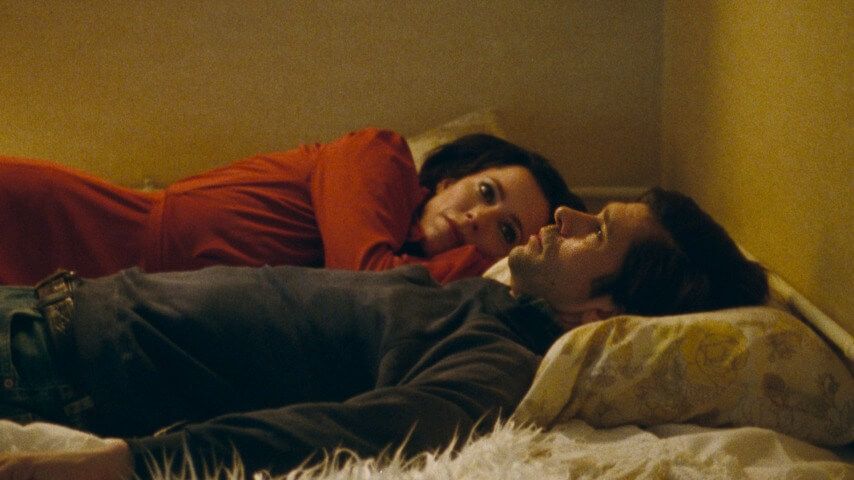
Photographer Peter Hujar often felt like his days were uneventful and that he’d let them slip by, as he shared in a recorded conversation with his friend, writer Linda Rosenkrantz. Rosenkrantz was developing a unique book project, asking artists to carefully document their everyday experiences. It was a seemingly simple idea, but she envisioned it as a kind of investigation into daily life. As an artist herself, Rosenkrantz questioned whether she, too, was wasting her days, or if even the most ordinary moments held hidden meaning.
The book project was never finished, and a recording of an interview with Hujar was lost. However, a written copy of the interview surfaced in 2019. Director Ira Sachs, known for his focus on the subtle nature of everyday conversations, used this transcript to create a beautifully understated film. The film draws attention to the filmmaking process itself, showing things like an actor blocked by equipment and sound technicians at work. It’s both a realistic portrayal and a thoughtful exploration of how reality becomes something else entirely when it’s remembered and then shared.
Peter Hujar was a remarkably gifted photographer. He was a key figure in the New York art world of the 1970s and 80s, and his honest portraits helped elevate American photography while also supporting the growing gay rights movement. By the time he spoke with Rosenkrantz, he had already worked on Andy Warhol’s famous Screen Tests and documented the first gay liberation march in 1970. Later, he published a book of portraits featuring a diverse range of subjects, including writer William S. Burroughs and photographer Susan Sontag.
The film subtly weaves in details from the conversations between Hujar and Rosenkrantz, blending them with surprisingly everyday moments. They might discuss Hujar’s work with Allen Ginsberg – who strongly resisted being photographed for a portrait – and then casually order Chinese food. Sachs reminds us we’re watching a film, and it feels that way: a normal day captured and transformed by the camera and sound. This approach highlights the remarkable beauty found in the simple, ordinary aspects of life.
Through Recreation, Sachs Suggests The Interchangeability Of Fiction & Non-Fiction
Of course, nothing about Hujar’s life felt truly ordinary, considering who he was and the world he moved in. He described a day starting with a strange encounter with an editor from Elle magazine, who he suspected was simply a devoted fan of model Lauren Hutton, whom he had previously photographed. The rest of the day was spent photographing Ginsburg for the New York Times, followed by returning home to develop his film. What’s striking is how casually Hujar would mention encounters with remarkable people – Fran Lebowitz, Richard Avedon, Maurice Hogenboom, Tuli Kupferberg, and many others – as if they were just everyday acquaintances, like mentioning a trip to the grocery store.
Hujar initially thought his day had been unremarkable, but when he reflected on it closely, a wealth of detail emerged. His keen observations of ordinary life blossomed into profound inspiration. Like many gifted and independent artists, Hujar found significant meaning in small moments. Throughout his work, he explored themes of sexuality, the act of creating photographs in the darkroom, his conflicted feelings about fame, and the challenges of making art within a capitalist system.
I was completely captivated by Peter Hujar’s Day. The filmmaker, Alex Ashe, who’s a photographer himself, shot it beautifully on grainy film – it really feels cinematic and intimate. The camera moves slowly, focusing on these little moments between Hujar and Rosenkrantz with such tenderness. It feels less like a traditional documentary and more like you’re just there with them, like a cozy coffee date that just naturally extends into a long evening. And it’s fascinating – they weren’t romantic partners, but the film still feels incredibly sensual and close.
The close connection between the characters is largely due to the authentic dialogue, but it’s also beautifully portrayed by Whishaw. He brings a unique vulnerability to the role, breathing life into an artist previously known only through written descriptions. Hall’s performance is more subtle, as her character often simply reacts to others, but she skillfully conveys just as much about Rosenkrantz through her expressions as we learn about Hujar, making her a fully realized character.
The film likely jumps between moments because the original transcript didn’t show the passage of time or what happened during breaks. We see the two characters casually eating snacks one moment, then gazing at the New York City skyline the next. This creates a surprisingly melancholic feeling, evoking a bygone era. In today’s world, it’s rare to simply sit and chat with a friend, or to freely discuss creative ideas – things that were commonplace then. Through this beautiful film, Sachs offers us a gift: a chance to reflect, to pause, and to experience a day in the life of Peter Hujar. It truly was a special day.
Read More
- Mobile Legends: Bang Bang (MLBB) Sora Guide: Best Build, Emblem and Gameplay Tips
- Brawl Stars December 2025 Brawl Talk: Two New Brawlers, Buffie, Vault, New Skins, Game Modes, and more
- Clash Royale Best Boss Bandit Champion decks
- Best Hero Card Decks in Clash Royale
- Call of Duty Mobile: DMZ Recon Guide: Overview, How to Play, Progression, and more
- Best Arena 9 Decks in Clast Royale
- Clash Royale December 2025: Events, Challenges, Tournaments, and Rewards
- Clash Royale Best Arena 14 Decks
- Clash Royale Witch Evolution best decks guide
- All Brawl Stars Brawliday Rewards For 2025
2025-11-06 18:58